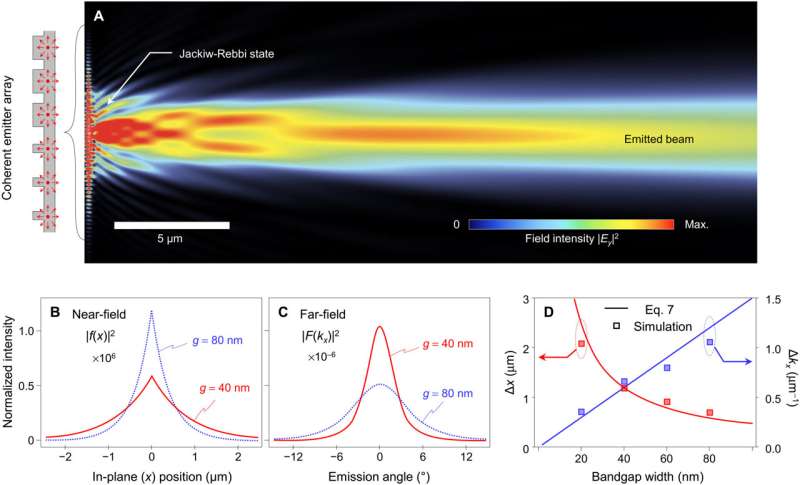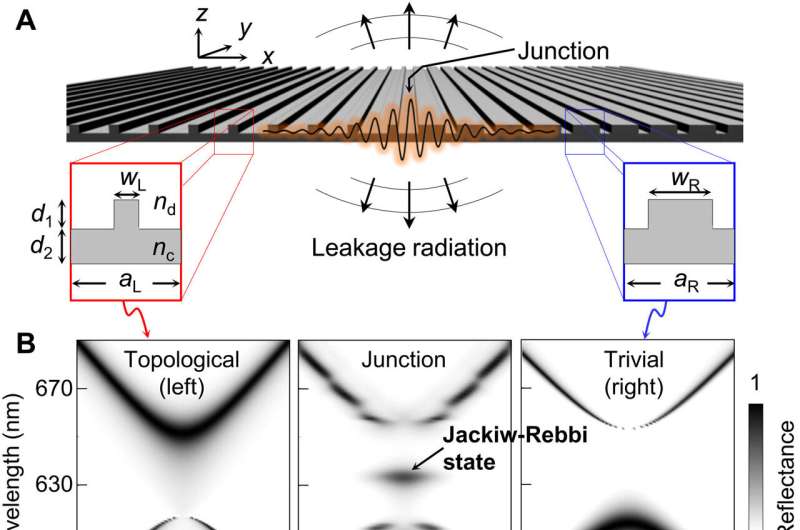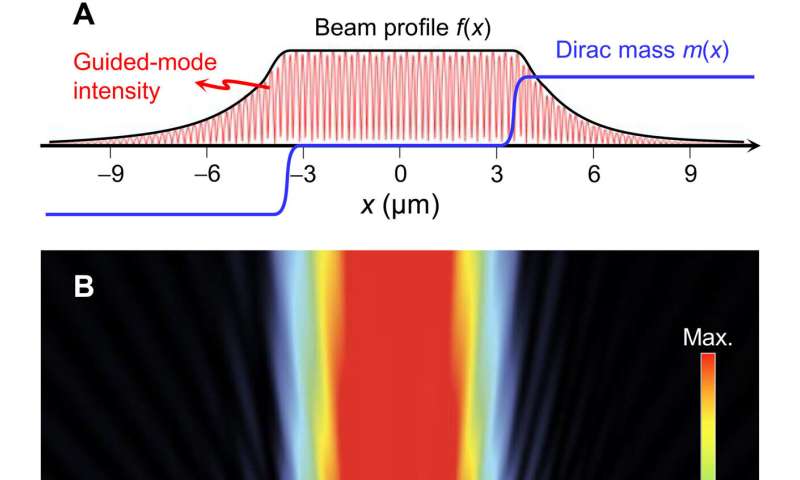December 30, 2022 feature
Study explores topological beaming of light

Nanophotonic light emitters are compact and versatile devices with wide-ranging applications in applied physics. In a new report now published on Science Advances, Ki Young Lee and a research team in physics and engineering in the Republic of Korea and the UK, proposed to develop a topological beam emitter structure of a submicron-footprint size and high efficiency, with adaptable beam shaping capacity.
The proposed device facilitated a highly desirable and efficient microlight emitter to detect a variety of applications including displays, solid-state light detection, optical interconnects and telecommunications.
Photonic topological phenomena
Topological interface states have remarkably high robustness against environmental disturbances with unique physical properties. Many researchers in mathematics and photonics have extensively investigated the photonic topological phenomena due to their promise across telecommunications, data processing and sensor applications.
In this study, Lee and colleagues explored novel far-field optical properties associated with non-Hermitian topological photonics. They showed how a topological junction metasurface of two guided-mode resonance gratings can serve as efficient submicron scale light emitters with high quantum efficiency and adaptable beam-shaping capacity.
During the experiments, the team used a junction containing two distinct guided mode resonant gratings directly adjacent to each other in the absence of an aperture. In such structures, the leaky Jackiw-Rebbi (JR) state at the junction; which corresponds to a historically important relativistic model—emitted a narrow beam of light. The process was driven by cavity-quantum electrodynamics coupling and electromagnetic funneling effects. The team explored a fundamental theory of topological beam emission and conducted rigorous numerical analyses during the study.

Leakage radiation from a Jackiw-Rebbi (JR) state
Lee et al. explored the leaky JR state localized at a photonic topological junction metasurface, where the structure maintained a high-index film. Under specific conditions, the first-order diffraction from the JR state led to beam leakage radiation towards the surrounding background, enabling characteristic features of leakage radiation to be gathered during the study.
Based on the narrow-beam emission associated with the leaky JR state, the team investigated the emission properties of light sources near the topological junction. They used the finite element method to calculate the radiation pattern, which showed a narrow beam emitted in the optical far-field. The team next disclosed the possibility of designing an appropriate structure, where two grating regions would have identical Dirac mass to achieve ideal symmetry of the emitted beam.
During these experiments, the narrow beam emission from isotropic light sources followed the exact diffraction properties of radiation leakage from the JR state. The team also considered external sources for the proposed beaming effect, which they accomplished by introducing modifications to the experimental setup, including a reduced index contrast and vertically coupled multilayer waveguides, among other modifications.
-

Electromagnetic funneling and Purcell enhancement of internal sources. (A) Optical power-flow (time-average Poynting vector 〈S〉t; red arrows) distribution for a topological junction with bandgap size g = 40 nm in reference to the near-field intensity distribution (gray-level density). (B and C) Optical power flow excited by a single isotropic source 1 and 2 μm away from the junction (xP = 1 and 2 μm), respectively. (D) Source-position (xP)–dependent far-field intensity distribution on an observation plane 3.5 μm above the grating surface as a function of xP. (E) Purcell factor distribution in comparison with the near-field intensity distribution associated with the JR state. Credit: Science Advances, doi: 10.1126/sciadv.add8349 -

Flat-top beam generation by Dirac mass control. (A) Dirac mass m(x) distribution for flat-top beam generation. It has three plateaus at m′ = −0.634, 0, and +0.635 μm−1, and associated JR state intensity profiles and emitted beam profiles are plotted together for references. (B) Electric field intensity |Ey|2 pattern from the structure design based on the Dirac mass distribution in (A). The device structure in this simulation has three grating regions of different fill factors at F = 0.264, 0.46, and 0.7, corresponding to the three Dirac mass plateaus. Credit: Science Advances, doi: 10.1126/sciadv.add8349
Adaptable beam shaping
The concept of beam shaping is important for many general applications of light sources. The described topological beaming effect provides a possibility of regulating the beam shape directly from the source. The scientists described the Dirac mass distribution required to generate the expected beam profile.
For instance, to generate a flat top beam, a zero Dirac mass region can be extended—across the desired width, and around the junction of the device. The outcomes of guided mode resonance Dirac mass regulation can thereby efficiently facilitate beam shaping applications.
Outlook
In this way, Ki Young Lee and colleagues proposed a topological junction metasurface for efficient beam emission. They simulated the characteristic field distributions of a leaky Jackiw-Rabbi state at the junction to achieve efficient light beaming from internal emitters by integrating cavity-quantum electrodynamics coupling with electromagnetic funneling effects.
The proposed architecture is significant to the creation of efficient micro-light emitters for strong localization, high quantum efficiency and adaptable beam shaping capacity. These properties are significant for numerous applications, including the development of display pixels, laser machining and telecommunications applications. The proposed devices are also capable of functioning as efficient optical detectors due to their scope of acting as time-reversed emitters, in principle. The scientists propose further optimizations of the study outcomes to develop new optical effects and concomitant device applications to surpass any existing technical limits.
More information: Ki Young Lee et al, Topological beaming of light, Science Advances (2022). DOI: 10.1126/sciadv.add8349
Alexander Cerjan et al, Experimental realization of a Weyl exceptional ring, Nature Photonics (2019). DOI: 10.1038/s41566-019-0453-z
Journal information: Nature Photonics , Science Advances
© 2022 Science X Network





















